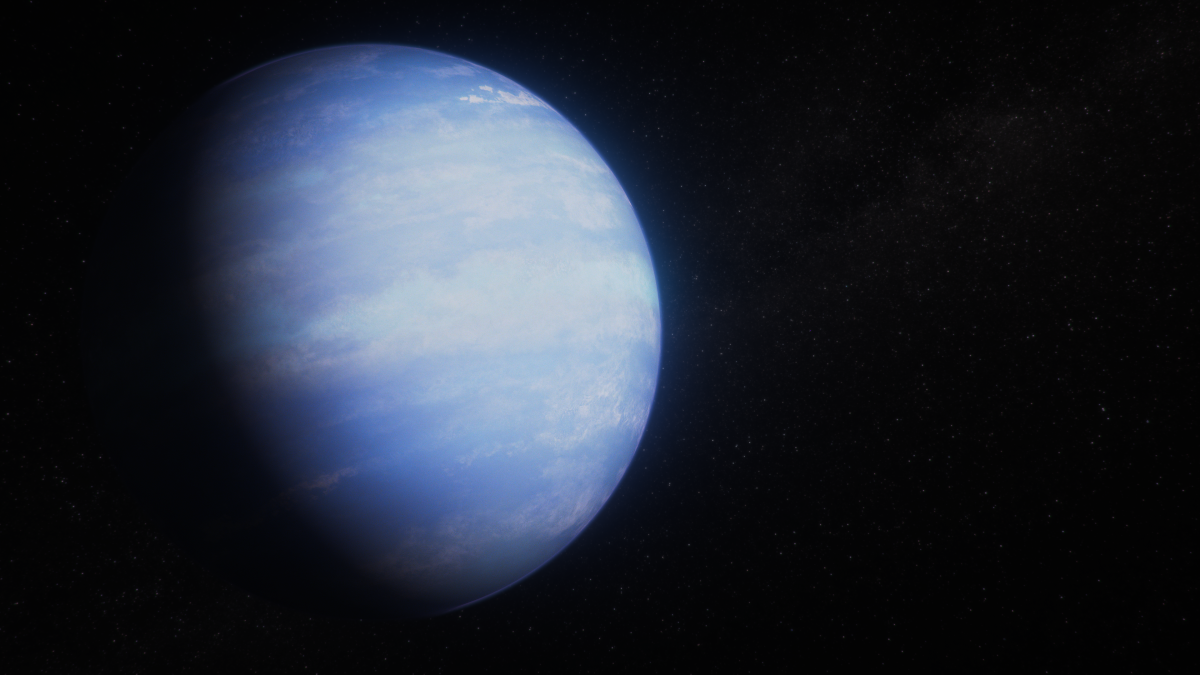ASU scientists help resolve 'missing methane' problem of giant exoplanet

Warm gas-giant exoplanet WASP-107b (artist's concept). Image courtesy NASA, ESA, CSA, Ralf Crawford (STScI)
In the quest to understand the enigmatic nature of a warm gas-giant exoplanet, Arizona State University researchers have played a pivotal role in uncovering its secrets.
WASP-107b has puzzled astronomers for some time, but recent findings, aided by NASA's James Webb Space Telescope and the Hubble Space Telescope, have shed new light on its unusual characteristics.
A remarkable revelation in the exploration of WASP-107b is the unforeseen scarcity of methane, or CH4, in its atmosphere. This intriguing discovery, hinting at a significantly hotter interior and a more massive core than previously hypothesized, has been a focal point of the research conducted by Luis Welbanks, a NASA Sagan Postdoctoral Fellow at the School of Earth and Space Exploration at ASU and lead author on a paper published today in Nature.
The high temperature is believed to be a consequence of tidal heating induced by the planet's slightly noncircular orbit.
“Based on its radius, mass, age and assumed internal temperature, we thought WASP-107b had a very small, rocky core surrounded by a huge mass of hydrogen and helium,” Welbanks said. “But it was hard to understand how such a small core could sweep up so much gas and then stop short of growing fully into a Jupiter-mass planet.”
Welbanks and the team's analysis, in conjunction with data from the Hubble Space Telescope, has led to a deeper understanding of WASP-107b's composition and dynamics. Contrary to earlier assumptions, the planet's inflated atmosphere does not result from extreme formation scenarios but rather from internal heat and tidal forces.
WASP-107b, a Neptune-like exoplanet discovered in 2017, has been identified as a pivotal subject for the study of low-density exoplanets. Its unique characteristics, offering valuable insights into planetary evolution and atmospheric dynamics, have been unraveled through advanced spectroscopic techniques by the researchers. The wealth of information about the molecules present in WASP-107b's atmosphere, including the simultaneous detection of carbon-, oxygen-, nitrogen- and sulfur-bearing molecules for the first time in a transiting exoplanet, further underscores its scientific value.
"The Webb data tells us that planets like WASP-107b didn't have to form in some odd way with a super small core and a huge gassy envelope," said Mike Line, associate professor in the School of Earth and Space Exploration at ASU. "Instead, we can take something more like Neptune, with a lot of rock and not as much gas, just dial up the temperature, and poof it up to look the way it does."
Overall, the groundbreaking research on WASP-107b underscores the importance of collaborative efforts in advancing our understanding of exoplanets. The research team's contribution, in conjunction with the support of NASA's James Webb Space Telescope and the Hubble Space Telescope, has been instrumental in this endeavor.
Video by Stephen Filmer/ASU
More Science and technology

No one left behind: AI-enabled support for aging vets
Loneliness has been called the silent killer. The U.S. surgeon general has described the negative health effects of social isolation as being as damaging as smoking cigarettes. While many aging…

ASU researchers contribute to groundbreaking discovery on exoplanet formation
A team of astronomers have discovered the small exoplanet GJ 3470 b shrouded in a surprising yellow haze of sulfur dioxide, making the planet a prime opportunity for scientists trying to understand…

ASU researchers gain insight into how a deadly strain of salmonella fine-tunes its infection tactics
Disease-causing microbes have evolved sophisticated strategies for invading the body, flourishing in often hostile environments and evading immune defenses. In a new study, Professor Cheryl…